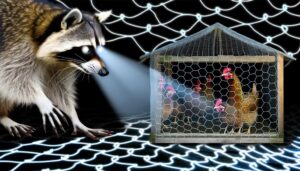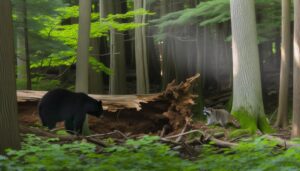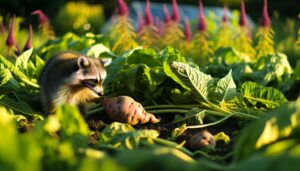Do Raccoons Eat Each Other: Understanding Their Behavior
Cannibalism among raccoons is a rare phenomenon but can occur under extreme conditions such as severe food scarcity and intense intra-species competition. As omnivores, raccoons exhibit highly adaptable feeding habits, but territorial disputes and limited resources can intensify aggressive behaviors, leading to conspecific consumption.
While cannibalism in raccoons is not a predominant survival strategy, it highlights the complex interactions within their social hierarchy and the pressures of their environment. This behavior is more likely in resource-limited urban settings where competition is heightened.
Understanding the triggers and implications of such events can offer deeper insights into raccoon behavior and ecology.
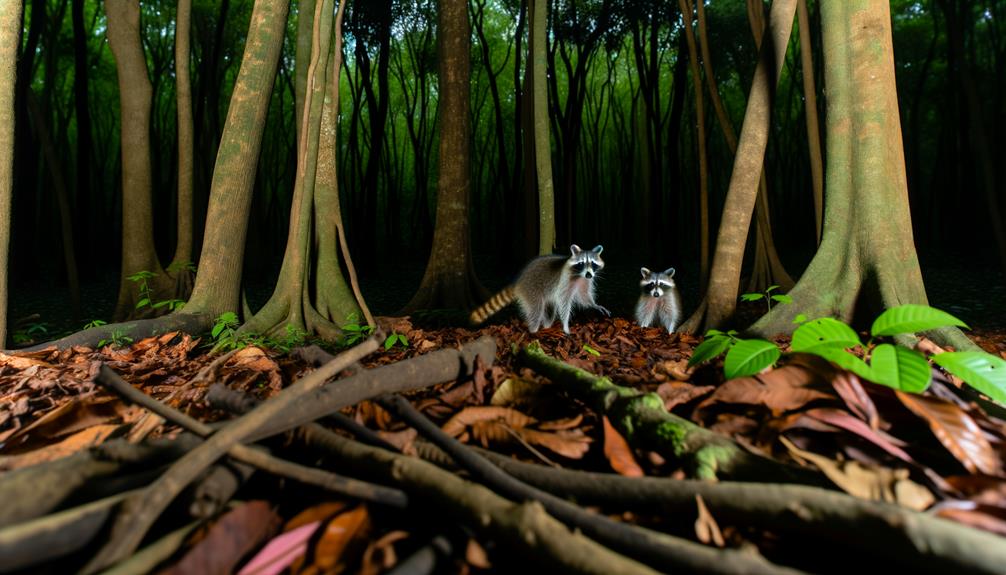
Key Takeaways
- Raccoons may resort to cannibalism during periods of extreme food scarcity.
- Territorial disputes can lead to cannibalistic behavior among raccoons.
- Intra-species competition for limited resources increases the likelihood of cannibalism.
- Cannibalism among raccoons is a survival adaptation in resource-poor environments.
- Cannibalistic behavior in raccoons is influenced by social hierarchy and dominance.
Raccoon Dietary Habits
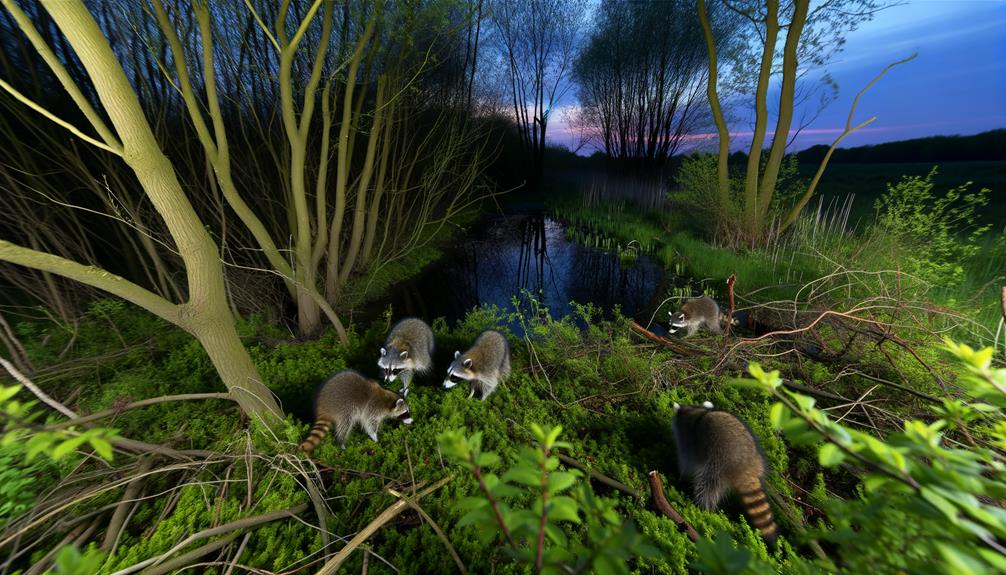
Raccoons exhibit an omnivorous diet, consuming a diverse array of food sources ranging from fruits and nuts to small animals and invertebrates. This dietary adaptability allows raccoons to thrive in various environments, including urban, suburban, and wild settings.
Their feeding habits are influenced by seasonal availability, with a preference for high-calorie foods in preparation for winter. In spring and summer, raccoons often consume berries, insects, and small vertebrates such as frogs and birds. During autumn, they prioritize nuts and seeds, which are abundant and energy-rich.
Additionally, raccoons are known to forage in human habitats, scavenging for food waste. This opportunistic feeding behavior underscores their ecological flexibility and capacity to exploit diverse nutritional resources.
Natural Predators
While raccoons are skilled foragers with diverse dietary habits, they must also navigate a landscape teeming with natural predators that pose significant dangers to their survival. Chief among these predators are larger carnivores such as bobcats, coyotes, and foxes, which actively hunt raccoons, especially juveniles and smaller individuals.
Additionally, birds of prey like great horned owls and eagles can pose a risk, particularly during the night when raccoons are most active. Domestic dogs also present a significant risk in urban and suburban environments. Moreover, raccoons are susceptible to diseases such as canine distemper and rabies, which can indirectly increase predation risks by weakening their physical condition and defensive capabilities.
Understanding these dangers is essential for comprehending raccoon survival strategies.
Omnivorous Tendencies
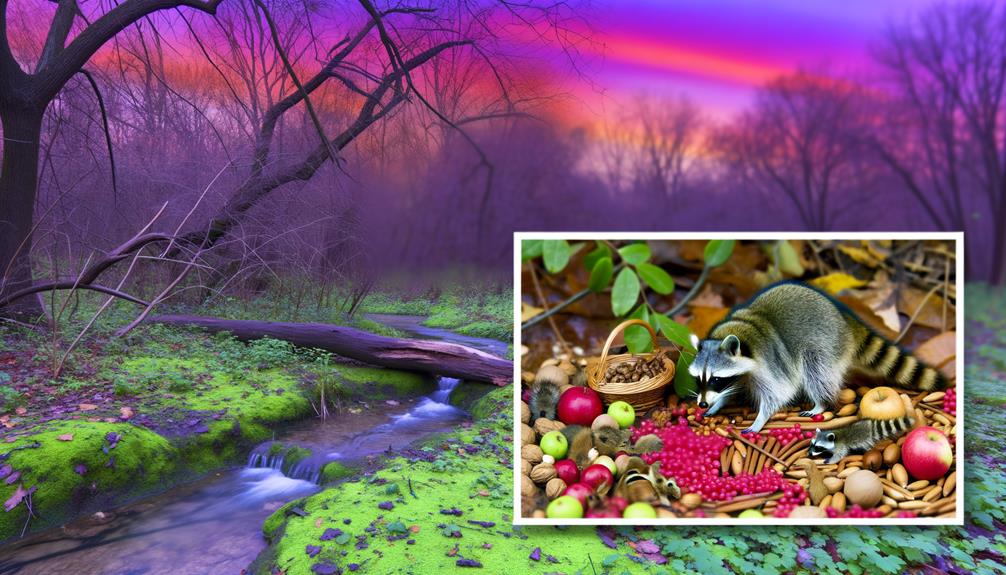
Possessing a highly adaptable diet, raccoons exhibit omnivorous tendencies that allow them to consume a wide array of food sources, ranging from fruits and vegetables to small animals and insects. This dietary flexibility enables raccoons to thrive in diverse environments, from urban areas to dense forests. Their opportunistic feeding habits are a key factor in their survival and reproductive success.
| Food Source | Nutritional Category | Example |
|---|---|---|
| Fruits | Carbohydrates | Apples, berries |
| Vegetables | Vitamins and Fiber | Corn, leafy greens |
| Small Animals | Protein | Frogs, birds, rodents |
| Insects | Protein and Fats | Beetles, ants, caterpillars |
Such varied consumption patterns illustrate the raccoon's ability to exploit different ecological niches, contributing to their widespread distribution and adaptability.
Cannibalism in Nature
Though raccoons are known for their omnivorous dietary habits, it is vital to examine the phenomenon of cannibalism within the animal kingdom to understand its implications and prevalence among various species.
Cannibalism, defined as the act of consuming individuals of the same species, occurs in a wide range of animals, from insects to mammals. Various species, including lions, sharks, and certain amphibians, exhibit cannibalistic behavior under specific conditions.
This behavior can be driven by factors such as food scarcity, population control, and reproductive advantages. Cannibalism in nature is not merely a survival mechanism but can also influence social structures and evolutionary processes.
Understanding these dynamics provides essential insights into the complex interactions within ecosystems.
What Triggers Cannibalism
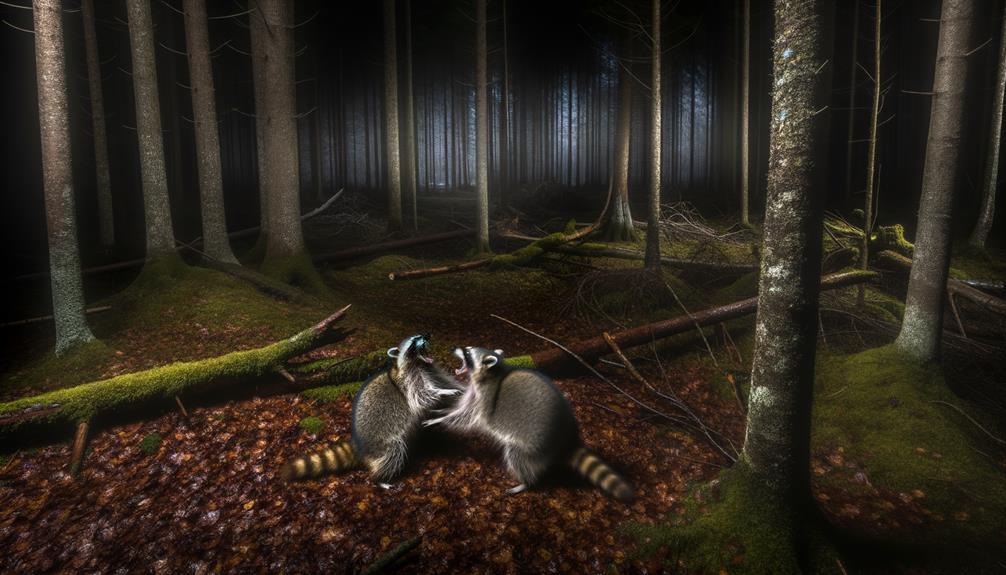
Cannibalism in raccoons is triggered by various factors such as scarcity of food, which forces individuals to resort to extreme measures for survival. Additionally, inherent survival instincts can drive raccoons to consume conspecifics, especially in highly competitive environments.
Territorial disputes further exacerbate this behavior, as dominant individuals may kill and consume rivals to maintain control over resources.
Scarcity of Food
In periods of extreme food scarcity, raccoons may resort to cannibalism as a survival mechanism. This behavior, although relatively rare, has been observed in situations where alternative food sources are severely limited.
The phenomenon is primarily driven by the need to obtain sufficient nutrients to sustain life. Factors contributing to such scarcity include environmental changes, reduced availability of natural prey, and habitat encroachment by humans.
In these dire circumstances, raccoons may target weaker or younger members of their own species. This adaptive response underscores the impact of ecological stressors on animal behavior.
Understanding these triggers can provide insights into the complex interplay between environmental conditions and survival strategies in wildlife populations.
Survival Instincts
Understanding the factors that trigger cannibalistic behavior in raccoons necessitates a closer examination of their innate survival instincts and adaptive responses to extreme environmental pressures. Raccoons, like many other species, exhibit cannibalism primarily under conditions of acute resource scarcity. This behavior can be attributed to their need to maximize survival probabilities when faced with limited food availability.
Additionally, overcrowding and stress can provoke aggressive interactions, sometimes culminating in cannibalism. Juvenile raccoons are particularly vulnerable during these periods, as adult raccoons may resort to consuming them to reduce competition for resources. This behavior underscores a complex interplay between environmental stressors and survival strategies, illustrating how raccoons adapt to and mitigate the challenges of their often unpredictable habitats.
Territorial Disputes
Territorial disputes among raccoons, often exacerbated by limited space and resources, can serve as a significant catalyst for cannibalistic behavior. In densely populated areas, competition for food, shelter, and mating opportunities intensifies. When these essential resources are scarce, aggressive interactions may escalate, leading to fatal outcomes.
In such conflict scenarios, dominant raccoons may kill subordinates, and instances of cannibalism can occur as a byproduct of these lethal encounters. This behavior is not driven by dietary preference but rather by ecological pressures and survival strategies. The propensity for territoriality is particularly pronounced during breeding seasons, when male raccoons are more likely to engage in violent clashes.
Understanding these dynamics is vital for comprehending the broader ecological context of raccoon behavior.
Food Scarcity Effects
Food scarcity greatly impacts raccoon behavior, leading to increased instances of cannibalism as a survival strategy.
The competition for limited resources intensifies, forcing raccoons to resort to extreme measures, including preying on conspecifics.
Such behavior underscores the adaptive responses to environmental stressors within raccoon populations.
Increased Cannibalistic Behavior
Driven by severe food scarcity, instances of cannibalistic behavior among raccoons have been documented, highlighting a survival strategy under extreme conditions. This phenomenon, though rare, underscores the adaptive behaviors raccoons employ when traditional food sources are depleted.
Scientific observations reveal that such behaviors are often a last resort, emerging only when environmental pressures become insurmountable.
- Behavioral Adaptation: Cannibalism is a drastic measure to guarantee survival in the face of starvation.
- Nutritional Necessity: Consuming conspecifics provides essential nutrients otherwise unavailable.
- Population Dynamics: Cannibalism may influence population control, reducing competition for limited resources.
- Psychological Stress: Extreme food scarcity can induce significant stress, altering typical social behaviors.
Such findings contribute to a broader understanding of raccoon behavior in response to ecological stressors.
Competition for Limited Resources
As cannibalistic behaviors emerge under dire circumstances, raccoons also face intense competition for limited resources, which further worsens the effects of food scarcity on their population dynamics.
In environments where food is scarce, raccoons exhibit heightened aggression and territoriality, leading to increased intra-species conflict. This competition not only impacts their physical health but also affects breeding success and juvenile survival rates.
Additionally, food scarcity can drive raccoons to forage in risky urban areas, increasing human-wildlife conflicts. Studies indicate that in severely resource-limited settings, raccoons prioritize immediate survival over social bonds, sometimes leading to cannibalism.
Understanding these dynamics is essential for wildlife management and conservation efforts, particularly in habitats undergoing rapid environmental changes.
Territorial Behavior
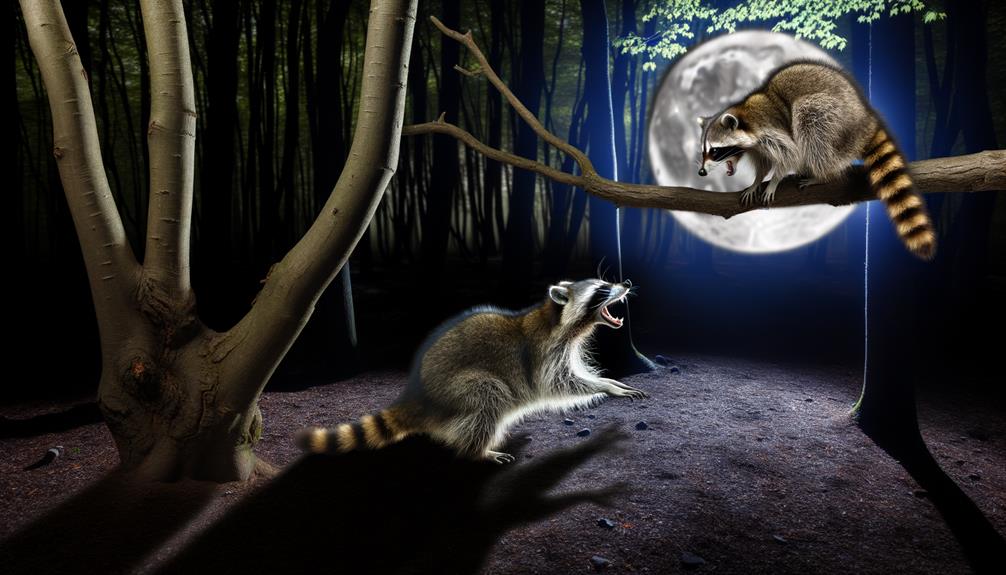
Raccoons exhibit distinct territorial behavior, which plays a pivotal role in their social structure and interactions. Territoriality in raccoons is primarily influenced by the need to secure resources such as food and shelter.
Male raccoons tend to have larger territories compared to females, which overlap with those of multiple females, facilitating mating opportunities. Females, on the other hand, are highly territorial and aggressively defend their range, especially during the breeding season.
Key aspects of raccoon territorial behavior include:
- Scent Marking: Utilizes scent glands to demarcate territory boundaries.
- Vocalizations: Employ a variety of sounds to communicate presence and ward off intruders.
- Physical Confrontations: Engage in fights when territorial disputes arise.
- Nocturnal Patrols: Active primarily at night, patrolling their territory to ensure no trespassing.
Social Hierarchy Impact
The social hierarchy within raccoon groups greatly influences access to resources, including food, with dominant individuals often securing the majority of available sustenance.
This hierarchical structure can lead to intragroup aggression, where subordinates may face increased competition and stress, potentially affecting survival and behavior.
Understanding these dynamics is key for comprehending the broader implications of social interactions on raccoon cannibalistic tendencies.
Dominance and Food Access
In raccoon populations, social hierarchy plays a crucial role in determining access to food resources, with dominant individuals often securing better and more consistent nutrition. This hierarchical structure influences various aspects of their behavior and survival.
- Resource Allocation: Dominant raccoons have priority access to high-quality and abundant food sources.
- Nutritional Health: Superior access to nutrition enhances the physical health and reproductive success of dominant individuals.
- Foraging Efficiency: Subordinate raccoons often rely on less preferable foraging sites, leading to increased energy expenditure.
- Survival Rates: Higher food access among dominant raccoons correlates with improved survival rates, especially during resource-scarce periods.
The social hierarchy hereby impacts the overall health and longevity of raccoon populations.
Intragroup Aggression Dynamics
Intragroup aggression among raccoons is strongly influenced by social hierarchy, manifesting in various behavioral interactions where dominant individuals often exert control over subordinates through physical confrontations and displays of aggression. This hierarchical structure is pivotal in determining access to resources such as food and mating opportunities.
Dominant raccoons typically exhibit pronounced aggressive behaviors, including biting, chasing, and vocal threats, to maintain their status and suppress challenges from lower-ranking members. These interactions are essential for establishing and reinforcing social order within raccoon groups.
Understanding the dynamics of intragroup aggression provides insight into their social organization and the ecological pressures that drive these behaviors, contributing to a broader comprehension of raccoon social systems and their survival strategies.
Urban Vs. Wild Raccoons
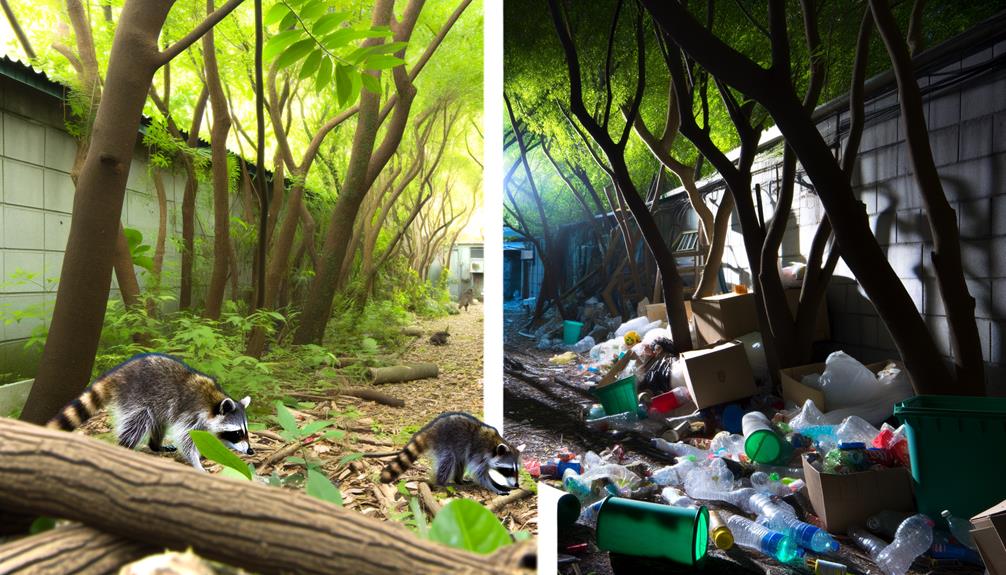
Urban raccoons, driven by the abundance of anthropogenic resources, exhibit distinct behavioral and dietary patterns compared to their wild counterparts. In urban settings, raccoons have adapted to exploit readily available food sources such as garbage, pet food, and bird feeders, which influences their foraging behavior and nutritional intake.
Conversely, wild raccoons rely on natural food sources including fruits, nuts, insects, and small vertebrates, which necessitates more complex foraging strategies and energy expenditure. This divergence impacts social interactions and aggression levels within raccoon populations.
- Dietary Diversity: Urban raccoons consume processed food, while wild raccoons eat a natural diet.
- Foraging Behavior: Urban raccoons forage opportunistically, whereas wild raccoons engage in more traditional hunting and gathering.
- Energy Expenditure: Urban raccoons expend less energy securing food.
- Social Dynamics: Urban environments may alter raccoon social structures.
Case Studies
Examining specific instances of raccoon behavior across different environments, case studies provide valuable insights into how varying access to resources impacts social interactions, dietary habits, and survival strategies.
In one study conducted in a forested region, researchers observed raccoons displaying cannibalistic behavior during periods of extreme food scarcity.
Contrastingly, a separate urban study found no evidence of such behavior, likely due to the abundance of anthropogenic food sources.
Another case study noted that raccoons in captivity exhibited aggressive interactions when food was limited, occasionally leading to fatal outcomes.
These case studies collectively highlight that resource availability is a critical factor influencing whether raccoons might resort to cannibalism, with environmental context playing a significant role in their behavioral adaptations.
Expert Opinions
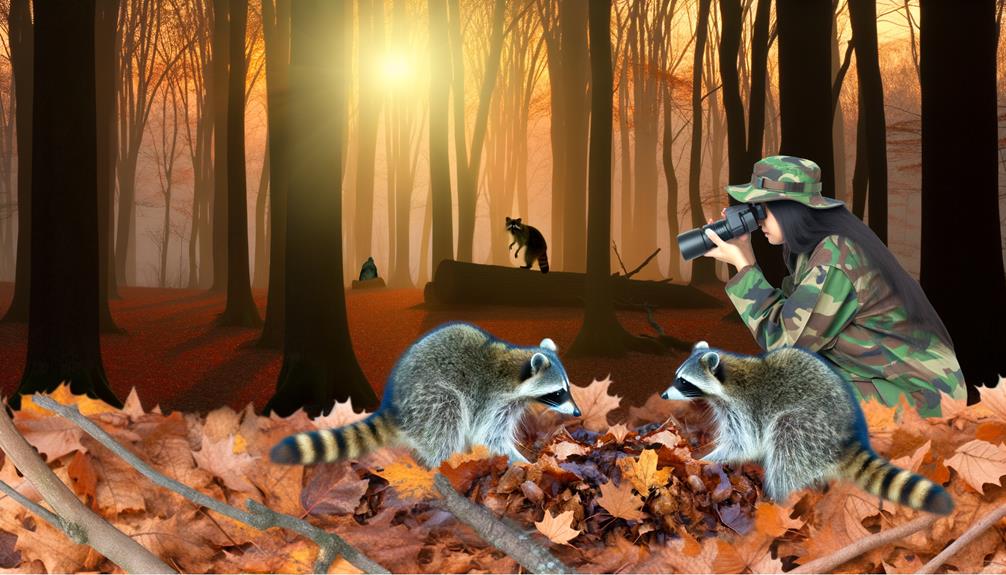
Drawing on years of research and field observations, experts emphasize that cannibalistic behavior among raccoons is primarily driven by severe food shortages and environmental pressures. Such incidents are rare but can manifest under extreme conditions.
Scientific studies have highlighted several critical factors:
- Resource Scarcity: Limited access to food sources can push raccoons to desperate measures, including cannibalism.
- Habitat Encroachment: Urban development and deforestation reduce natural habitats, intensifying competition for resources.
- Population Density: High population densities can escalate aggressive interactions, potentially leading to cannibalistic behavior.
- Nutritional Stress: Malnutrition and starvation are potent drivers, forcing raccoons into survival tactics that are otherwise unnatural.
These insights underline the complex interplay between ecological stressors and animal behavior, prompting a need for further investigation and potential intervention strategies.
Preventive Measures
To mitigate the risk of cannibalistic behavior among raccoons, it is indispensable to implement strategies aimed at alleviating resource scarcity and reducing environmental pressures.
Ensuring consistent and adequate food supply is vital; supplemental feeding programs can help maintain nutritional balance. Habitat management practices, such as preserving natural foraging areas and minimizing habitat fragmentation, are also pivotal.
Additionally, controlling raccoon population densities through humane methods can reduce competition and stress. Implementing public education campaigns to discourage feeding raccoons and secure waste can prevent scavenging behaviors.
Monitoring and research efforts can provide data on population health and inform adaptive management strategies. These measures collectively contribute to a stable environment, minimizing the likelihood of cannibalistic tendencies among raccoons.
Conclusion
The labyrinthine dietary habits of raccoons reveal a tapestry woven from omnivorous tendencies and survival instincts.
While cannibalism among raccoons is a rare phenomenon, it is not entirely absent from the natural world. Triggered by extreme circumstances, such as scarcity of food, this behavior underscores the complex interplay between environmental pressures and animal behavior.
The dichotomy between urban and wild raccoons further accentuates varied adaptive strategies, demanding a nuanced understanding of their ecological roles and preventive measures.

